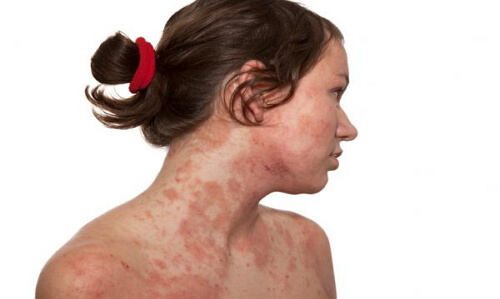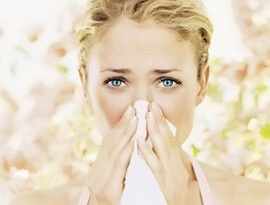Allergy to dust
 Allergies to dust - is widely spread in recent years of an allergic reaction to the present in every house dust mite, which is manifested lacrimation, sneezing and runny nose. According to the World Health Organization, an allergy to household dust is observed in about 40% of the world's population and often leads to various diseases of the respiratory tract and bronchial asthma.
Allergies to dust - is widely spread in recent years of an allergic reaction to the present in every house dust mite, which is manifested lacrimation, sneezing and runny nose. According to the World Health Organization, an allergy to household dust is observed in about 40% of the world's population and often leads to various diseases of the respiratory tract and bronchial asthma.
Allergists consider household dust to be one of the most dangerous and common allergens, becauseIn it often there is a huge quantity of various irritating components. And it's not just ordinary dust particles, but also microscopic particles of paint, pet hair, fluff, as well as viruses and bacteria. In addition, home dust is always invisible to the human eye tiny mites( their size 0.1-0.3 millimeters) of house dust - saprophytes that can cause a truly huge harm to human health. The greatest concentration of mites is observed in bedding, where the most optimal conditions for their possible reproduction and further development are created. Only in 1 gram of dust from the mattress or cushion can be from 200 to 15000 mites! Direct stimulus are not tick bites( they do not bite human), and their waste products, which enters the body is sensitive to this human allergen, cause severe allergic reactions. Allergy to dust does not occur in people who are not susceptible to this particular allergen. In addition to mites, molds, cockroaches, animal hair and other irritants can often cause an allergic reaction.
To date, allocated about one hundred and fifty species of ticks, able to live in people's homes. Home dust mites are divided into three groups, with only ticks of the first group causing an allergy to dust. The first group includes some barn mites that live in places where food is stored - vegetables, flour, cereals and grains. The second group includes predatory dust mites, which feed on the mites of the first group. The third group includes mites, which accidentally got into house dust. The second and third groups do not cause an allergy to dust.
Dust mites can easily exist even in sub-zero temperatures, it is virtually impossible to remove from upholstered furniture and carpets conventional vacuum cleaner, because in addition to its tenacious claws they secrete enough adhesive, thereby clinging to every surface. Inside the soft furniture mites can penetrate to a depth of up to thirty centimeters. 
Some types of dust mites can cause occupational allergic disease in working with contaminated their food people - cheesy dermatosis, dermatosis grocers, dermatosis bakers etc.
Allergies to dust -
symptoms Dust allergy can manifest itself differently, but all the symptoms are very unpleasant and clearly visible. The most common symptoms of allergies to dust are similar to the symptoms of allergy to pollen, it is itching and redness of the eyelids, watery, itchy nose, runny nose, skin rashes, asthma, sneezing, coughing and asthma attacks. Allergy to house dust accompanies a person regardless of the season throughout the calendar year, which with confidence allows you to exclude allergies to plants and various colds. Characteristic is the fact that in the case of a long absence in an apartment infected with ticks, the person's well-being is markedly improved and the symptoms fade. Below we will consider the most common symptoms of dust allergy:
• Allergic rhinitis( hay fever).It is not very heavy, but the ability is strong enough to spoil the life of human disease characterized by clear discharge from the nose, sneezing, itching and burning sensation in the nose and throat, headache and tear. Rinit begins with a slight tickling in the nose and gradually develops into a torturous continuous sneeze. In some cases, allergic rhinitis develops into such a serious disease as bronchial asthma. Virtually any allergen( food, mold, animal hair, etc.) can cause it, but the main culprit in the development of rhinitis is dust. After contact with the allergen, the response in the form of the appearance of the corresponding symptomatology usually develops almost instantaneously, but in some cases it may be slightly delayed. This occurs in the case of constant contact with the provoking allergen
• Conjunctivitis. This disease is a fairly common manifestation of allergy to dust. About 15% of the population at least once faced this problem. Conjunctivitis is characterized by a feeling of itching and / or burning in the eyes, reddening of the proteins, redness and swelling of the eyelids, lacrimation. Sometimes the vision may also suffer - the surrounding objects look "blurred".People with contact lenses are most likely to suffer from conjunctivitis. The worst outcome of conjunctivitis is a severe corneal lesion
• Bronchial asthma. Allergic asthma is the most common form of bronchial asthma, for example, in Russia for example, it suffers from every twelfth resident, and the dynamics of growth in recent years has become truly menacing. After the allergic irritant enters the respiratory tract, the immune defense begins to give a quick sharp rebuff to the foreign agent - the airways become inflamed, filled with thick mucus, and the muscles of the respiratory tract decrease sharply. To start an attack of allergic asthma is characterized by a dry agonizing cough and shortness of rapid wheezing. In the chest feels a sense of heaviness, there is shortness of breath. Due to lack of breathing air, a person often has a panic condition. Allergic asthma in young children in severe cases can even lead to death, so if there is an allergy to dust in the child, immediate measures should be taken to treat it and further prevent it. Unfortunately very often doctors take asthma for usual bronchitis and accordingly appoint inadequate treatment that can only worsen the situation
Dust allergy - treatment
In case all of the above symptoms are most pronounced in the morning and / or at night, and outdoors quickly enough disappear, the causeThis indisposition is most likely in the home dust. Appropriate adequate treatment can be prescribed only by the doctor an allergist, however it will not have the slightest effect if it does not qualitatively combat the original cause - home dust.
Treatment of dust allergy should always have an integrated approach. First of all, the contact of the patient with the provoking allergen should be completely ruled out. This is the most difficult task, since it is impossible to remove mites from carpets or furniture with an ordinary vacuum cleaner. Particular attention should be paid to the bedroom - bed linen should be changed at least once a week, it is necessary to wear dustproof covers on mattresses. Pillows and blankets should be chosen with synthetic fillers, since they are not for breeding mites a favorable environment. Bedding must be washed at high temperatures.
At least twice a week, it is necessary to vacuum and conduct in the room a high-quality wet cleaning. In order to reduce the humidity of the air( with increased humidity household clamps are accelerated), a dehumidifier or air conditioner should be used. Airing an apartment is also necessary regularly. In the case of a persistent allergy to dust, carpeting should be completely discarded, replacing them with vinyl or wood.
Allergy treatment for dust is carried out with the help of anti-inflammatory drugs prescribed by the allergist and antihistamines. In food should be present a large amount of vitamin C( citrus, greens, elder, currant, sweet pepper, etc.), which significantly reduces the increased susceptibility to allergens.
Well-proven methods of dust control:
• When cleaning the apartment and when washing it in water, you should add tea tree oil
• Curtains and bed linen must be washed in hot water
• Floors must be washed with salt solution for 10 litersWater five spoons of salt
Allergy is very insidious able to manifest itself at any age of the disease. Disease, stress, lifestyle changes - all this significantly weakens immunity and often causes the fact that until recently a completely healthy person suddenly becomes allergic. Therefore, the refusal to eat harmful products, smoking, qualified timely treatment, regular cleaning of the apartment and a healthy lifestyle will help successfully cope with the developed allergy to dust.



